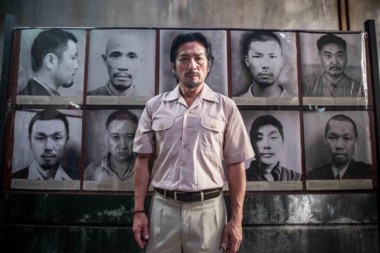War is hell, the saying goes. But what it leaves off is that hell doesn’t always stay behind when a soldier comes home. In the last hundred years or so of human history we’ve fought some terrible conflicts, and if today we’re slightly better at caring for those sometimes hidden wounds war leaves behind, it’s hard to believe that anyone back home can truly, fully, understand the real horror that can slip into a psyche during wartime. This week, a new film explores a terrifying ordeal as experienced by a soldier who lived through it—and his meeting many years later with the man who put him there.
Colin Firth (The King’s Speech) and Nicole Kidman star in The Railway Man, a drama that tells of a dark chapter of World War II that is largely unspoken of today, even by (and maybe especially by) the men who lived through it. Firth stars as Eric Lomax, a British Army officer whose true story forms the basis for the film, screening at Amherst Cinema.
Captured and held as a prisoner of war by the Japanese, Lomax and his compatriots were sent to a labor camp, where they were forced to work on a 250-mile stretch of railway that would run between Thailand and what was then Burma. Plotted through thick jungle and crossing many rivers (one of which was immortalized in David Lean’s 1957 film The Bridge on the River Kwai), the project would be the death of many thousands of workers, civilian and POW alike. But while Lomax survived what would become known as The Death Railway, his life for years after was marked by the torture he suffered at the hands of his Japanese captors.
If the camp itself was almost unbearable, it was one man in particular—an interpreter named Takashi Nagase—who was responsible for much of the mistreatment Lomax suffered, and despite the years Lomax never forgot him. When the news comes, decades after the war has ended, that Nagase is still alive, Lomax and his partner Patti (Kidman) make the decision to go and confront him. That remarkable step—the after-effects of which Lomax chronicled in the book upon which the film is based—would set in motion a chain of events that finally allowed Lomax to put his troubled past to rest. Sad to say, Lomax passed away while the long-gestating film was still in the editing room. But his story, both in war and at peace, may prove to last a long time yet.
Also this week: Amherst College wraps up the Spring 2014 installment of its ongoing German Film Series with Dietrich Brüggemann’s 2012 film Move. An understated comedy set in present day Germany, it adopts the multi-narrative structure that has become a common cinematic reflection of our increasingly connected social circles. In it, eight 20-somethings try to navigate the modern maze of careers, relationships, and—perhaps most important of all—finding a good apartment.
While Move is the last film in the current run, the series—which screens a free film on irregular Thursdays, with an afternoon and evening showing in the college’s Stirn Auditorium—is a nice resource to keep in mind, especially for film fans who have exhausted the usual local offerings but still hanker for a cinematic morsel. After all, autumn, though we may not want to consider it just yet, will come again.
And finally this week, Tradition is a Temple screens Monday night at Amherst Cinema. A documentary in which contemporary New Orleans musicians talk about the importance of music in the city’s life, and what the potential “death” of traditional jazz could mean for its future, it will be accompanied by a live jazz introduction and commentary by NEPR Jazz à la Mode host Tom Reney.•
Jack Brown can be reached at cinemadope@gmail.com.



